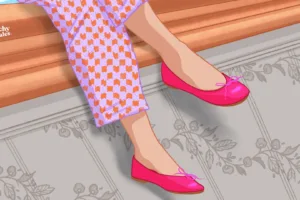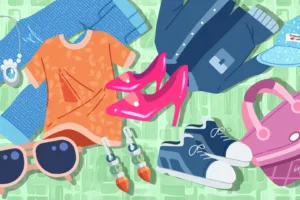Slow fashion: saving the world, one dress at a time
If you come across those cute flare jeans you used to wear in the 70s, don’t throw them away. Give them a second chance. Ok, you might have put on a bit of weight since then, but you can turn them into a practical tote bag or even a bib. By looking after what we already own, through mending or upcycling, we not only keep our most loved clothes out of the landfill but also we create a timeless style with garments that we truly love.
Slow fashion, a term that was coined by Kate Fletcher of the Centre for Sustainable Fashion, encourages mixing and matching garments that we have, to swop clothing with friends, to explore vintage markets, and to indulge in items that we will actually treasure for longer than two weeks. It is about evolving a personal style and incorporating consciousness into fashion, not manically following seasonal trends but rather staying true to ourselves. Repair, donate, upcycle our garments is also a way to save the planet: doubling the useful life of an item of clothing from one year to two can reduce emissions over the year by 24%, according to Greenpeace.
Slow Fashion also puts emphasis on the art of clothes making and celebrates the skills of the craftspeople who make them. It involves buying better-quality garments, made from more sustainable processes, less often. A different approach, in which designers, buyers, retailers and consumers are more aware of the impacts of products on workers, communities and ecosystems. This increase in quality, usually comes with a higher price tag, but that shouldn’t put us off from making a purchase. Instead, let’s think of the price per wear (ppw) and how this decreases when we buy a piece that we truly love and that will stick around with us for longer.
To really support the Slow Fashion movement, we need to look beyond the appeal of the cheap, high turnover of fast fashion. We can maintain awareness of what a brand is really representing and focus on quality, not quantity by simplifying our wardrobes. We can make a difference, supporting secondhand businesses or investing in sustainable and ethical clothing companies that pay their employees a fair living wage (among them: Everlane, Eileen Fisher, Thought Clothing, Able, Back Beat Rags, Klow, Matter Prints). We can also shop consciously looking for sustainable choices and good fabric such as organic cotton and bamboo, lyocell (made from wood pulp ), modal (made from beech wood), Piña silk (made from pineapple leaves) or Abaca, which is made from banana stalks and cotton.
Slow Fashion has seen increasing support in the last few years, with awareness from consumers demanding higher sustainability and ethical standards. As research shows, 19% of the top fast fashion-related searches are linked to the environment, ethics and sustainability. All around the globe, Slow Fashion Festivals are growing in popularity, as well as ethical vintage markets. In Australia, pre-loved item lovers queue up early in the morning for attending The Slow Fashion Market (Sydney, Melbourne, Canberra) in order to find the best in local established and emerging sustainable fashion under one roof. In the meantime, online global platforms, such as Slow Fashion World, empower slow fashion visionaries to act upon their passions and values creating a shared space to challenge the norm, make their voice heard and tackle the issues facing the fashion industry.
So, how can we champion sustainability?
Buy less, choose well and make it last. We can buy clothes made locally by ethical labels or extend our wardrobe’s lifespan by mending. We can call a local clothing repairer or, better yet, join the #visiblemending movement, which encourages entirely obvious and colourful hand-sewn repairs. When buying a garment, we should ask #whomademyclothes for further insight on the company’s production processes, or read Fashion Revolution’s online annual report to know a bit more about the brands we buy.
Fashion Revolution is a global movement that scrutinises industry practices while raising awareness of the fashion industry’s most pressing issues, encouraging those who are on a journey to create a more ethical and sustainable future for fashion. Its goal is to change the way our clothes are sourced, produced and consumed. Next month (22nd – 28th April 2019), during the Fashion Revolution Week, they will launch #whomademyclothes campaign, which falls on the anniversary of the Rana Plaza factory collapse, which killed 1138 people and injured many more on 24th April 2013. That is the day the Fashion Revolution was born. During this week, brands and producers are encouraged to respond with the hashtag #imadeyourclothes and to demonstrate transparency in their supply chain.




